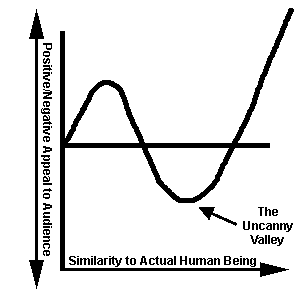The film Simone was a comedy about a computer-generated actress, but a live actress was used to play the part of the artificial. There was much speculation on this decision, from budget costs to Screen Actors Guild concerns influencing the decision, but the real answer was obvious. A computer-generated actress would scare the audience away.
To support this conclusion, I cite the film Final Fantasy: The Spirits Within. This entirely computer-generated film created a buzz that a new era in film production was at hand, one where live actors would soon be replaced with lifelike computer-puppets. The film’s previews helped promote this speculation. In the glimpses we had of the characters, they looked flesh and blood, indistinguishable from real-life.
Yet, subjected to an hour and a half of scrutiny, the characters failed to convince. What went wrong? Each time I examine the film, I cannot put my finger on it. The skin and clothing seems to perfectly mimic real life. Each strand of hair blows like real hair. The characters can imitate the full range of human emotions. They run, jump, and kiss like live action, but they are not human. They are doppelgangers, almost disturbing in their attempt to mirror real flesh and blood.
This phenomenon is known as the “Uncanny Valley” effect, discovered by roboticist Doctor Masashiro Mori. The Uncanny Valley deals with the appeal of an artificial being, either robotic or computer animated. The more “human” the creation, the more appealing it becomes to the viewer. This is apparent in the anthropomorphism used in films such as Finding Nemo or Toy Story; however, there is a point when the creation too closely resembles a human and goes from being appealing or lovable to grotesque or artificial. The creation’s non-human aspects become exaggerated, all the more noticeable because of its failed attempt to imitate humanity.

Creatures from this realm so closely resemble real life that their imperfections stand out all the more, making them grotesque and visually unappealing. Because of this phenomenon, Directors and Special Effects teams must work carefully not to trigger this viewer response.
Navigating the “Uncanny Valley”
At first glance, the second Matrix film, Re-Loaded appears to blend live action into computer animation so well as to switch between Keanue Reeves’ and his animated counterpart seamlessly. Closer viewing will trigger an Uncanny Valley response. In the complex fight scenes, when the action becomes impossible for a live actor, a “stunt double” appears to take over, looking almost perfectly like Keanue Reeves, but obviously not him.
The effect works initially for the same reason magic tricks succeed. The action is swift and brief. The Director does not allow the audience opportunity to scrutinize it. Thus, a suspension of disbelief is maintained. This is the same reason Final Fantasy appeared effective in previews, but not in theaters. The more we watch the Matrix’s fight scene, the stranger the main character appears.
Another set of films that would seem to almost certainly evoke an Uncanny Valley response are the Lord of the Rings Trilogy. The most powerful effect in this film being the character Gollum. That something so realistic can fail to trigger the revulsion response in the audience would, at first, seem to be an example of overcoming the barriers Final Fantasy fell victim to. Gollum’s performance was so persuasive, in fact, that many people wondered if it could qualify for a Best Actor award.
Roger Ebert refuted such speculation simply. Gollum could not compete, because Gollum was not human. This is the reason the effect worked so well. We do not hold monsters to the same level of realism as we do human beings. They are monsters and therefore cannot fall into the Uncanny Valley, because they are not attempting to mimic anything in real life.
The incredible special effects achievements of films like The Matrix, Lord of the Rings, and the new Star Wars trilogy is that they do not create animated humans, but competently place humans in animated settings. Such a technique is effective enough not to trigger an unnatural response in the audience, so a new application of it has emerged: placing late actors in new environments.
Raising the Dead
The irony of the Uncanny Valley, is that when we take a dead actor and place them in a new setting by manipulating their old film footage, we are not disturbed. Fred Astair dances with a vacuum. Judy Garlan interacts with M&M’s. John Wayne and Humphrey Bogart hang out in beer commercials.
The classic question, since before this practice began, has been to ask how these late actors and actresses would feel about endorsing these products? The owners of the icons’ images are the decision makers in this respect. Whoever inherited Elvis’ estate has the power to choose how it shall be used.
So we see that live actors are no different than Mickey Mouse. They are treated as creations, a product. Their iconography can be sold and manipulated freely as the copyright-holder permits. Beyond the realm of copyright expiration, when these icons enter the public domain, remains an issue for the future.
There are ethical questions about such a system, but they are not within the realm of this essay. My purpose is merely to illustrate the blurred lines between reality and creation that our film society has created.
From its beginnings, the purpose of animation is to exceed human possibility. Animated characters can do the superhuman, exist in other dimensions, and engage issues our reality does not currently permit. As the lines between fact and illusion in our media blur, the day we might actually overcome the Uncanny Valley holds incredible consequences.